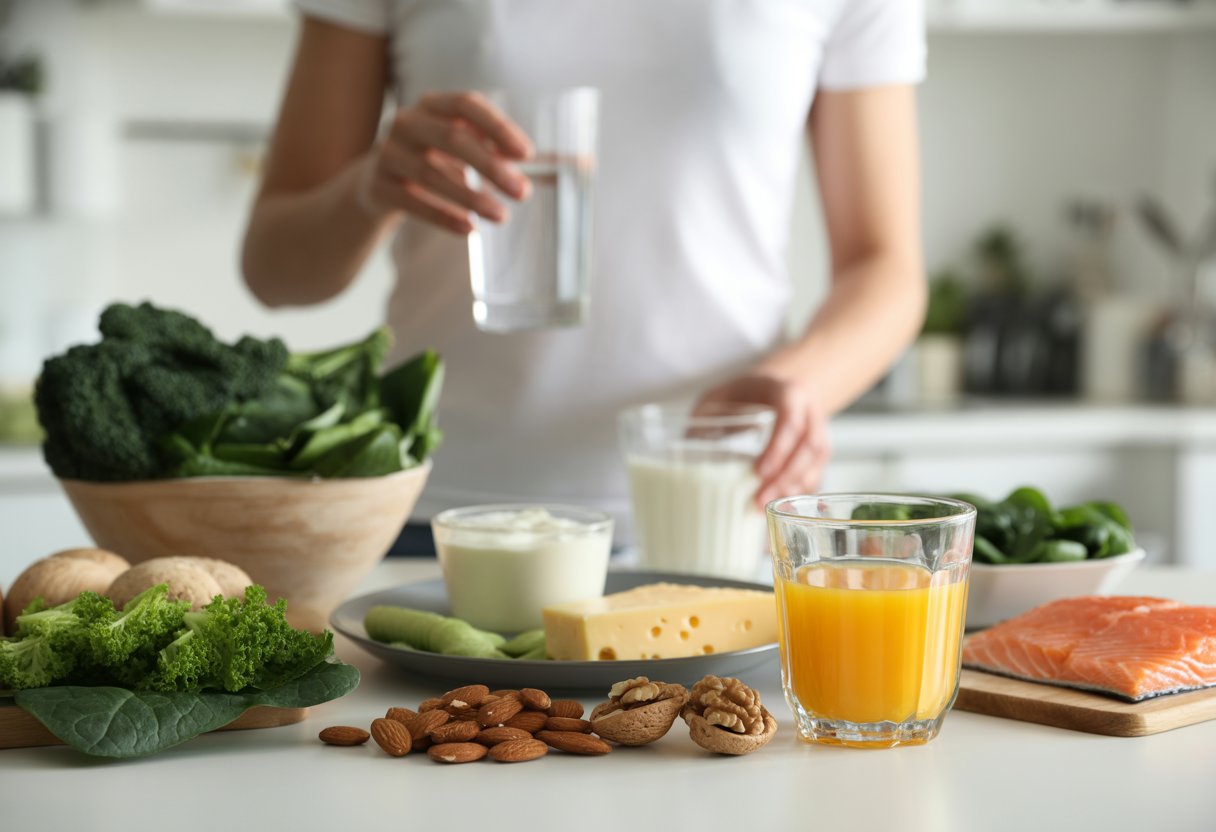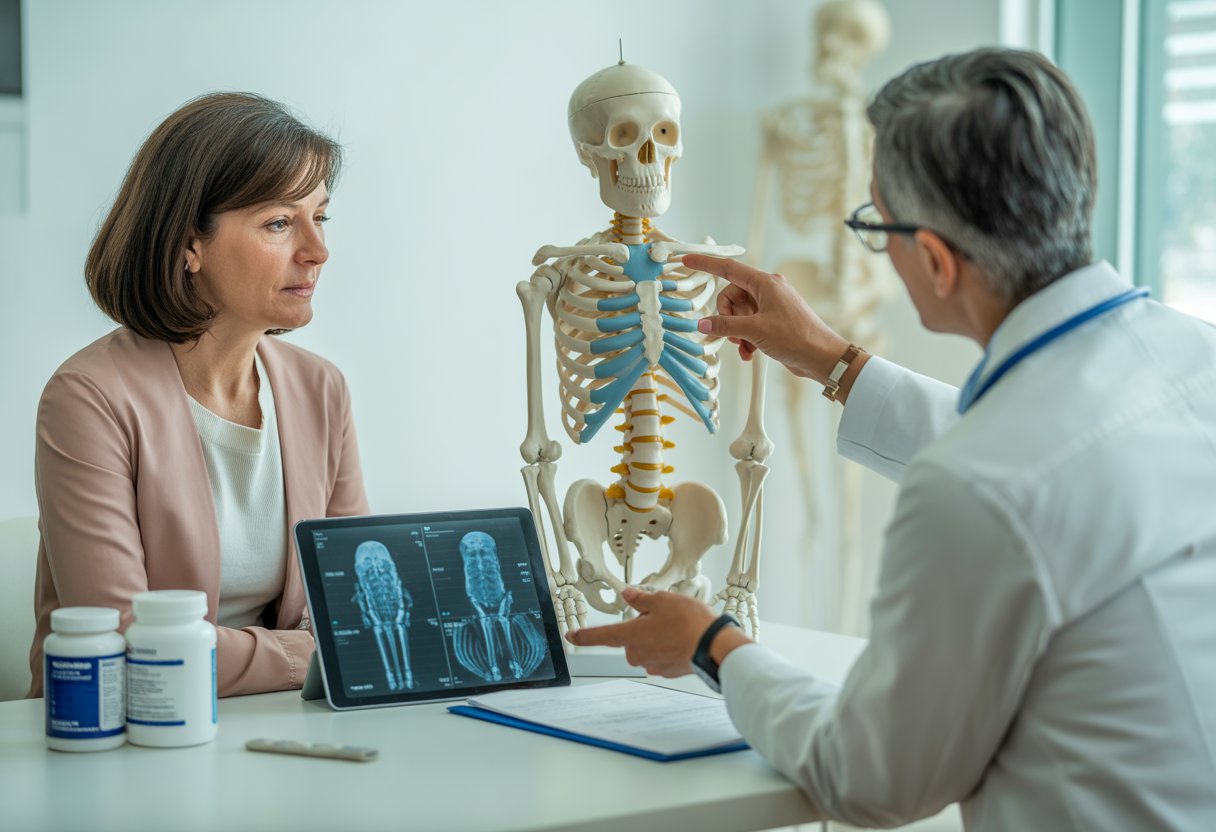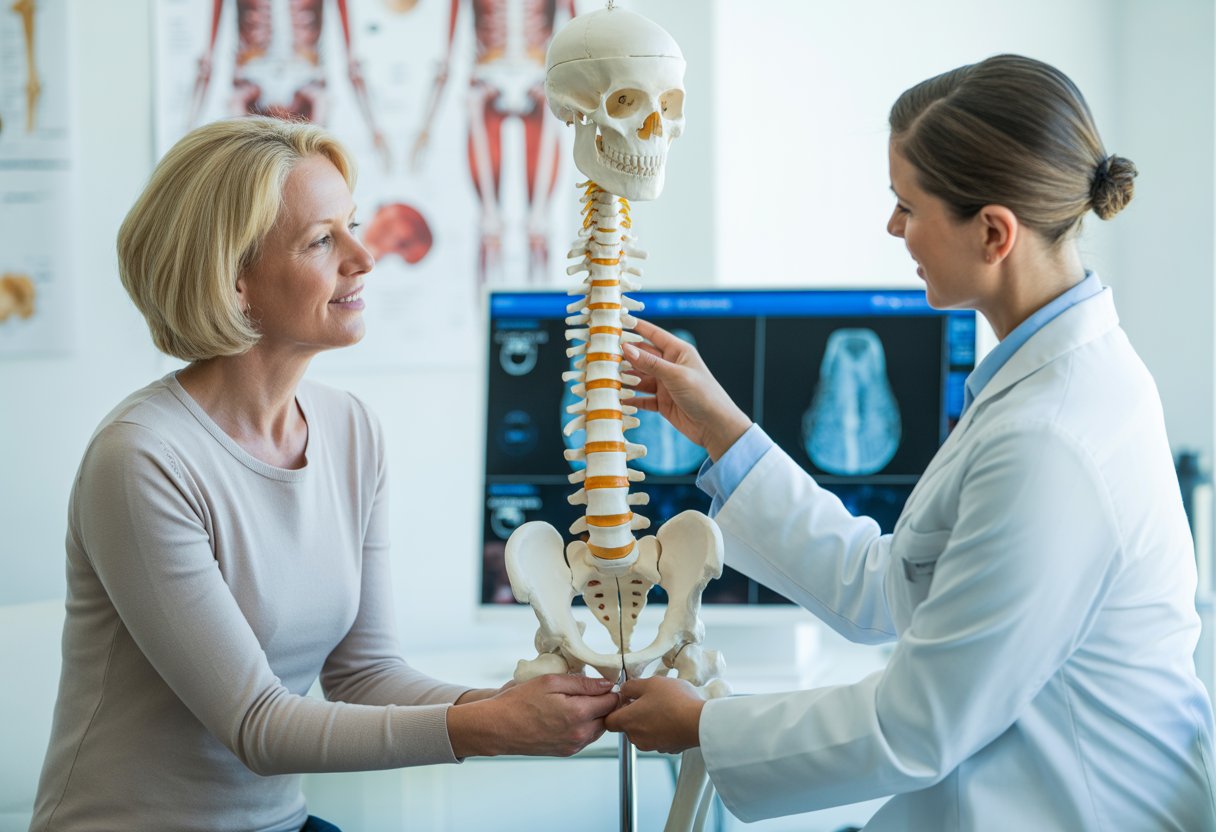Your bones constantly break down and rebuild throughout your life, but this process slows as you age, leading to weaker bones and higher fracture risk. The good news is that you can take active steps to strengthen your bones at any age through proven strategies that work with your body’s natural bone-building processes.

You can improve bone density through a combination of proper nutrition, regular weight-bearing exercise, and healthy lifestyle choices that support your skeletal system. Weight-bearing exercises can help increase bone density[1] by forcing your bones to work against gravity, while getting enough calcium and vitamin D gives your body the raw materials it needs for bone formation.
Simple changes like adding more dairy products to your diet, taking daily walks, and avoiding smoking can make a real difference in your bone health over time. Understanding which foods, exercises, and habits have the biggest impact on bone strength helps you create a plan that fits your lifestyle and protects your bones for years to come.
Key Takeaways
- Combining calcium-rich foods with vitamin D and regular weight-bearing exercise creates the foundation for stronger bones
- Daily activities like walking, climbing stairs, and strength training help stimulate bone growth and prevent bone loss
- Avoiding smoking, limiting alcohol, and maintaining a healthy weight are essential lifestyle habits for long-term bone health
Understanding Bone Density and Its Importance
Bone density measures how much mineral content exists in bone tissue and directly impacts fracture risk. Peak bone mass typically occurs around age 30, after which bones naturally lose density at varying rates depending on genetics, lifestyle, and hormonal factors.
What Is Bone Density?
Bone density refers to the amount of calcium and other minerals packed into a segment of bone. Dense bones contain more minerals per square inch than bones with lower density.
Healthcare providers measure bone density using a special X-ray test called DEXA scanning. This test compares an individual’s bone density to that of a healthy 30-year-old adult of the same gender.
The measurement appears as a T-score. A T-score of -1.0 or higher indicates normal bone density. Scores between -1.0 and -2.5 suggest osteopenia, while scores below -2.5 indicate osteoporosis.
Normal bone density ranges:
- Normal: T-score of -1.0 or higher
- Low bone mass (osteopenia): T-score between -1.0 and -2.5
- Osteoporosis: T-score of -2.5 or lower
Bone mineral density directly correlates with bone strength. Higher density means stronger bones that resist fractures better during falls or impacts.
Factors Affecting Bone Density
Age represents the primary factor influencing bone density. Bone mass peaks around age 30, then gradually decreases throughout life.
Women experience faster bone loss after menopause due to declining estrogen levels. Men lose bone density more slowly but face similar risks as testosterone decreases with age.
Key factors that reduce bone density:
- Smoking tobacco products
- Excessive alcohol consumption
- Sedentary lifestyle with limited physical activity
- Poor nutrition lacking calcium and vitamin D
- Certain medications like corticosteroids
Genetics play a significant role in determining peak bone mass and the rate of bone loss. Family history of osteoporosis increases fracture risk substantially.
Medical conditions can accelerate bone loss. These include rheumatoid arthritis, diabetes, kidney disease, and eating disorders that affect nutrient absorption.
Hormonal changes beyond menopause also impact bone health. Low testosterone in men and thyroid disorders can accelerate bone mineral density loss.
Bone Mineral Density and Peak Bone Mass
Peak bone mass occurs when bones reach their maximum density, typically between ages 25-30. The amount of bone mass accumulated during this period determines bone health later in life.
Building higher peak bone mass during youth provides protection against age-related bone loss. Individuals with greater peak bone mass maintain stronger bones longer as they age.
After age 30, bone remodeling shifts toward net bone loss. The rate varies significantly between individuals based on genetics and lifestyle factors.
Women lose approximately 1-2% of bone mass annually after menopause. Men experience slower loss rates of about 0.5-1% per year starting in their 40s.
Bone loss timeline:
- Ages 25-30: Peak bone mass achieved
- Ages 30-50: Gradual bone loss begins (0.5-1% yearly)
- Post-menopause women: Accelerated loss (1-3% yearly for 5-10 years)
- Ages 65+: Continued steady loss in both genders
The difference between peak bone mass and current bone mineral density determines fracture risk. Maintaining bone density through proper nutrition and exercise[2] becomes increasingly important as people age.
Dietary Strategies for Improving Bone Density

Nutrition plays a crucial role in building and maintaining strong bones throughout life. Key nutrients like calcium, vitamin D, magnesium, and vitamin K work together to support bone formation and prevent bone loss.
Role of Calcium in Bone Health
Calcium serves as the primary building block for bone tissue. The body stores about 99% of its calcium in bones and teeth. When dietary calcium intake falls short, the body pulls calcium from bones[3] to maintain blood calcium levels.
Adults need 1,000-1,200 mg of calcium daily. Dairy products like milk, cheese, and yogurt provide the most easily absorbed forms of calcium. One cup of milk contains approximately 300 mg of calcium.
Plant-based calcium sources include:
- Kale (180 mg per cup, cooked)
- Broccoli (60 mg per cup)
- Almonds (75 mg per ounce)
- Sardines with bones (325 mg per 3 oz)
Fortified cereals and plant-based milks offer additional calcium options. Many breakfast cereals contain 100-1,000 mg per serving.
Spinach contains calcium but also has compounds that reduce calcium absorption. Pairing calcium-rich foods with vitamin C sources can improve absorption rates.
The Importance of Vitamin D
Vitamin D acts like a key that unlocks calcium absorption in the intestines. Without adequate vitamin D, the body can only absorb 10-15% of dietary calcium instead of the normal 30-40%.
Vitamin D deficiency leads to bone loss[3] because the body cannot effectively use calcium from food sources. This forces the body to release stored calcium from bones.
Natural vitamin D sources include:
- Salmon (360-700 IU per 3.5 oz)
- Sardines (270 IU per 3.5 oz)
- Egg yolks (40 IU per yolk)
- Mushrooms exposed to UV light (400 IU per cup)
Most people need 600-800 IU of vitamin D daily. Fortified milk contains about 100-150 IU per cup. Many fortified cereals provide 40-100 IU per serving.
Sunlight exposure helps the skin produce vitamin D naturally. However, food sources and supplements often prove necessary in northern climates or during winter months.
Magnesium and Other Vital Minerals
Magnesium helps convert vitamin D into its active form and plays a direct role in bone formation. About 60% of the body’s magnesium is stored in bones. Low magnesium levels can disrupt calcium metabolism and weaken bone structure.
Adults need 310-420 mg of magnesium daily. Top magnesium sources include:
- Almonds (80 mg per ounce)
- Cashews (75 mg per ounce)
- Whole grains (25-50 mg per serving)
- Seeds like pumpkin seeds (150 mg per ounce)
- Legumes (60-120 mg per cup)
Other minerals support healthy bones too. Phosphorus works with calcium to form bone crystals. Zinc helps with bone tissue repair and growth.
Most nuts, seeds, and whole grains provide multiple bone-supporting minerals. A varied diet with these foods typically meets mineral needs better than focusing on single nutrients.
Vitamin K and Bone Mineralization
Vitamin K activates proteins that bind calcium to the bone matrix. This process helps ensure that calcium gets deposited in bones rather than soft tissues. Low vitamin K intake links to increased fracture risk and reduced bone density.
Two forms matter for bone health: K1 and K2. Leafy greens provide vitamin K1, while fermented foods and animal products contain K2.
Excellent vitamin K sources include:
- Kale (530 mcg per cup, raw)
- Spinach (145 mcg per cup, raw)
- Broccoli (90 mcg per cup, cooked)
- Brussels sprouts (220 mcg per cup)
Adults need about 90-120 mcg of vitamin K daily. One cup of raw kale provides more than four times this amount.
Vitamin K works best alongside calcium and vitamin D. This nutrient partnership ensures proper bone mineralization and maintains bone strength over time.
Weight-Bearing and Resistance Exercises for Bone Strength
Weight-bearing exercises force your body to work against gravity[4], while resistance training uses weights or bands to strengthen muscles and bones. These activities send signals to bone tissue to build stronger structures and increase density throughout the skeletal system.
Benefits of Weight-Bearing Exercise
Weight-bearing exercises create mechanical stress on bones through gravity and muscle contractions. This stress triggers bone cells to produce new tissue, increasing bone density over time.
Walking, jogging, and dancing are excellent weight-bearing activities that help build bone strength[5]. These exercises force the skeleton to support body weight while moving against gravity.
Research shows significant improvements in bone health from regular weight-bearing activity. One German study found postmenopausal women gained 11% bone mineral density in the hip after three years of strength training[4].
Key benefits include:
- Increased bone mineral density
- Stronger hip and spine bones
- Better balance and coordination
- Reduced fracture risk
Short bursts of varied activity work best for bones[5]. Alternating between running and jogging, or jogging and brisk walking, provides optimal bone stimulation.
Strength Training Techniques
Strength training uses weights, machines, or bodyweight to create resistance against muscle movement. This resistance strengthens both muscles and the bones they attach to.
Free weights like dumbbells target specific bone areas effectively. Squats strengthen hip and spine bones, while bicep curls work arm bones. The effects of strength training on bones are site-specific[4], meaning targeted exercises strengthen particular skeletal areas.
Effective strength training exercises:
- Squats – Hip and spine strengthening
- Deadlifts – Full body bone loading
- Overhead presses – Spine and arm bones
- Pushups – Arms, shoulders, and spine
High-intensity resistance training shows impressive results[4]. The LIFTMOR study found women gained 3% lumbar spine density and 13.6% hip thickness in just 8 months with twice-weekly sessions.
Beginners should start with lighter weights and focus on proper form. A qualified trainer helps ensure safe technique and appropriate progression.
Incorporating Resistance Bands and Bodyweight Exercises
Resistance bands provide variable tension that increases bone-building stress throughout movement ranges. These portable tools work well for home exercise routines.
Effective resistance band exercises:
- Chest pulls – Strengthen spine and shoulders
- Leg extensions – Target hip bones
- Arm curls – Build arm bone density
- Squats with bands – Add resistance to bodyweight movement
Bodyweight exercises use natural resistance to strengthen bones and muscles. Pushups, lunges, and step-ups require no equipment while providing excellent bone stimulation.
Simple bodyweight movements like tippy toes and chair stands effectively strengthen multiple bone areas[4]. Standing on toes and dropping back down creates impact that signals bones to strengthen.
These exercises fit easily into daily routines. People can perform them at home, work, or while traveling without special equipment or gym memberships.
Incorporating Yoga and Pilates
Yoga and Pilates improve bone health through sustained poses and controlled movements. These practices create tension from tendons pulling on bones while improving balance and posture.
Research shows just 10 minutes of daily yoga can improve bone density[4]. Holding poses creates prolonged bone loading that stimulates new tissue growth.
Beneficial yoga poses for bones:
- Tree Pose (Vrksasana) – Improves balance and leg bones
- Triangle Pose (Utthita Trikonasana) – Strengthens spine and hips
- Warrior II (Virabhadrasana II) – Builds leg and spine strength
Pilates focuses on spinal alignment and core strength[4]. The exercises strengthen small muscles around the spine while improving posture and reducing stress through breathing techniques.
Both practices help prevent falls through better balance and coordination. This fall prevention becomes increasingly important as people age and bone density naturally declines.
People with bone loss should seek classes specifically designed for bone health or work with instructors familiar with osteoporosis modifications.
Everyday Physical Activities That Support Bone Density
Simple daily activities like brisk walking and dancing can significantly strengthen bones by forcing them to work against gravity. These accessible exercises stimulate bone growth and help prevent bone loss without requiring special equipment or gym memberships.
Walking, Running, and Jogging
Walking serves as one of the most accessible weight-bearing exercises to improve bone density[1]. The key lies in walking pace and frequency.
Brisk walking produces better results than leisurely strolls. Research shows that people who took brisk 30-minute walks at least three days per week experienced reduced bone loss and improved bone health.
Running and jogging provide even greater bone-strengthening benefits. These higher impact activities increase weight on bones[6] more than walking alone.
However, people with existing bone density issues should consult doctors first. Those already diagnosed with osteoporosis may need to avoid high-impact activities like running to prevent fractures.
Walking Guidelines:
- Walk briskly for 30 minutes
- Exercise at least 3 days per week
- Maintain consistent pace throughout
- Choose varied terrain when possible
Dancing and Hiking for Bone Health
Dancing combines cardiovascular exercise with bone-strengthening movements. This weight-bearing exercise offers both aerobic and strengthening benefits[1] in one activity.
Studies show people with low bone density who danced three times weekly had higher bone measurements after 24 weeks. They also showed lower fracture and fall risks.
Active dance styles work best for bone health. Zumba and similar programs that keep people moving continuously provide optimal benefits.
Hiking adds variety to bone-strengthening routines. The uneven terrain challenges balance while providing weight-bearing exercise. Uphill sections increase intensity naturally.
Best Dance Options:
- Zumba classes
- Aerobic dance programs
- Ballroom dancing
- Folk dancing with jumping movements
Both activities require no special equipment and can be adapted to different fitness levels.
Lifestyle Habits to Prevent Bone Loss

Simple daily choices can significantly impact bone strength over time. Getting adequate sunlight, moderating certain beverages and foods, and staying physically active form the foundation of effective bone loss prevention[7].
Sun Exposure and Vitamin D Synthesis
The skin produces vitamin D when exposed to sunlight. This process is essential because the body needs vitamin D to absorb calcium[2].
Daily Requirements:
- Ages 51-70: 600 IU (15 mcg) minimum
- Ages 71+: 800 IU (20 mcg) minimum
- Maximum safe intake: 4,000 IU daily
Most people need 10-15 minutes of midday sun exposure several times per week. People with darker skin may require longer exposure times. Those living in northern climates or spending most time indoors face higher risk of deficiency.
Winter months and cloudy weather reduce vitamin D production. Indoor workers and individuals who wear covering clothing may need supplements or fortified foods to meet their needs.
Limiting Alcohol, Caffeine, and Sodium
Excessive consumption of certain substances interferes with bone metabolism. Alcohol use ranks among the key risk factors for bone density loss[2].
Alcohol Guidelines:
- Women: No more than 1 drink daily
- Men: No more than 2 drinks daily
Heavy alcohol consumption reduces bone formation and increases fracture risk. It also interferes with calcium absorption and vitamin D metabolism.
Caffeine and Sodium Impact: Consuming more than 400mg of caffeine daily may increase calcium loss through urine. High sodium intake has a similar effect, causing the kidneys to excrete more calcium.
People should limit processed foods, which contain high sodium levels. Adding extra salt to meals increases bone loss risk over time.
Avoiding a Sedentary Lifestyle
Physical inactivity contributes significantly to bone loss risk[7]. Bones become stronger when stressed through movement and weaker during periods of inactivity.
Movement Requirements:
- Minimum 150 minutes moderate exercise weekly
- Include weight-bearing activities
- Add strength training exercises
- Incorporate balance work
High-Risk Behaviors:
- Sitting for extended periods without breaks
- Avoiding stairs when possible
- Choosing elevators over walking
- Limited recreational activity
Even brief walking breaks throughout the day help maintain bone strength. People with desk jobs should stand and move every 30-60 minutes.
Simple Daily Changes:
- Park farther from destinations
- Take phone calls while standing
- Use stairs instead of elevators
- Walk during lunch breaks
Regular movement signals bones to maintain their density and strength.
Hormones, Health Conditions, and Bone Disease

Many hormones directly affect bone strength, with estrogen being the most critical for preventing bone loss. Certain health conditions can accelerate bone disease development, leading to osteopenia and osteoporosis that increase fracture risk.
The Role of Estrogen and Menopause
Estrogen serves as a key regulator of bone remodeling in both women and men. This hormone helps maintain the balance between bone formation and bone breakdown throughout life.
During menopause, estrogen levels drop significantly. This hormonal change accelerates bone loss at a rate of 1-3% per year for the first five to ten years after menopause.
Key Effects of Estrogen Loss:
- Increased bone breakdown (resorption)
- Decreased calcium absorption
- Reduced bone formation activity
- Higher risk of spine and hip fractures
Women experiencing perimenopause may consider hormone therapy[7] to address declining estrogen levels linked to bone loss. This treatment can help slow the rapid bone density decline that occurs during this transition.
The impact extends beyond the reproductive years. Post-menopausal women face the highest risk for developing serious bone diseases due to prolonged estrogen deficiency.
Osteopenia and Osteoporosis Awareness
Osteopenia represents the early stage of bone loss, where bone density falls below normal but hasn’t reached osteoporosis levels yet. Osteoporosis occurs when bones become severely weakened and porous.
The endocrine system produces hormones that are really important to bone health[8]. When hormone levels become imbalanced, bones become weak and more likely to break.
Bone Density Classifications:
- Normal: T-score above -1.0
- Osteopenia: T-score between -1.0 and -2.5
- Osteoporosis: T-score below -2.5
Several health conditions increase bone disease risk. Chronic diseases that may contribute to osteoporosis include inflammatory bowel disease, liver and kidney diseases, celiac disease, and diabetes[9].
These conditions affect bone health through various mechanisms, including nutrient malabsorption, chronic inflammation, and hormonal disruptions.
Reducing Risk of Fractures and Falls
Fractures represent the most serious consequence of bone disease. Hip, spine, and wrist fractures are most common in people with osteoporosis.
High-Risk Fracture Sites:
- Hip: Often requires surgery and lengthy recovery
- Spine: Can cause height loss and chronic pain
- Wrist: Frequently occurs from catching falls
Fall prevention becomes critical for people with bone disease. Environmental modifications can significantly reduce fracture risk.
Essential Safety Measures:
- Remove loose rugs and clutter
- Install grab bars in bathrooms
- Improve lighting in hallways and stairs
- Wear supportive, non-slip shoes
Balance and strength training exercises help prevent falls. These activities improve coordination and muscle strength needed to maintain stability during daily activities.
Regular bone density testing allows early detection of bone loss. This screening helps doctors recommend appropriate treatments before fractures occur.
Optimizing Long-Term Bone Health

Building strong bones requires a strategic approach that adapts to changing needs over time. Professional guidance becomes essential when risk factors increase or when standard prevention measures may not be sufficient.
Creating a Personalized Bone-Health Plan
A personalized bone health plan considers individual risk factors, age, and lifestyle demands. Women over 51 need 1,200 mg of calcium daily, while men require this amount after age 70.
Key components of an effective plan include:
- Nutrition tracking – Monitor daily calcium, vitamin D, and protein intake
- Exercise scheduling – Plan 150 minutes of weight-bearing activities weekly
- Risk assessment – Evaluate family history, medications, and medical conditions
- Timeline goals – Set measurable targets for bone density improvement
People with specific medical conditions need modified approaches. Those with diabetes, kidney disease, or eating disorders face higher bone loss risks and require adjusted nutrition plans.
Monthly plan reviews help track progress and identify necessary changes. Many individuals benefit from keeping a bone health journal that records exercise sessions, supplement intake, and dietary calcium sources.
The plan should evolve with age and health changes. What works at age 40 may need adjustment at age 60 when bone density naturally decreases with age[2].
When to Consider Professional Guidance
Professional guidance becomes necessary when bone health risks exceed normal parameters. A healthcare provider should evaluate bone mass when specific warning signs appear.
Immediate consultation is recommended for:
- Family history of osteoporosis or fractures after age 50
- Long-term steroid medication use
- Sudden height loss or spine curvature changes
- Fractures from minor falls or impacts
Healthcare providers can prescribe medications like bisphosphonates or denosumab when dietary and exercise interventions prove insufficient. These treatments specifically target bone mass preservation in high-risk individuals.
Professional testing includes:
- DEXA scans to measure current bone density
- Blood tests for calcium, vitamin D, and hormone levels
- Review of medications that may weaken bones
- Assessment of fall risk factors
Early intervention prevents more serious complications. Healthcare providers can prescribe certain medications to help boost bone density[2] when natural methods alone cannot maintain adequate bone strength.
Physical therapists design safe exercise programs for those with existing bone loss or mobility limitations.
Frequently Asked Questions

Building stronger bones takes time and consistency, with noticeable improvements typically occurring within 6-12 months of following proper nutrition and exercise protocols. People over 60 can still make meaningful gains through targeted interventions, though the process requires more focused attention to specific nutrients and weight-bearing activities.
How long does it typically take to improve bone density through diet and exercise?
Bone density improvements typically become measurable within 6 to 12 months of consistent dietary and exercise changes. The body needs time to absorb nutrients and respond to weight-bearing activities.
Most people see initial changes in bone markers through blood tests within 3 to 6 months. However, significant density improvements measured through DEXA scans usually require 12 to 24 months of consistent effort.
Weight-bearing exercises can help increase bone density[1] when performed regularly over extended periods. The bone remodeling process naturally occurs slowly, requiring patience and persistence.
Younger individuals may see faster results than older adults. People with severe bone loss may need longer to achieve noticeable improvements.
What actions can be taken to enhance bone density in individuals over 60 years of age?
Adults over 60 require 1,200 mg of calcium daily[2] along with adequate vitamin D intake. These nutrients become more critical as natural bone loss accelerates with age.
Resistance training and weight-bearing exercises remain effective for older adults. Activities like walking, stair climbing, and light weightlifting can stimulate bone formation safely.
Healthcare providers can prescribe medications[2] specifically designed to improve bone density in older adults. Bisphosphonates and other treatments may be necessary for those at high risk.
Protein intake becomes increasingly important after age 60. Adults should consume 0.36 grams of protein per pound of body weight daily to support bone health.
Is there a specific age beyond which improving bone density becomes significantly more difficult?
Bone density improvements remain possible at any age, though the rate of improvement slows after menopause in women and after age 70 in men. The body’s ability to build new bone decreases but does not stop completely.
Women experience rapid bone loss in the first few years after menopause due to declining estrogen levels. This period presents the greatest challenge for maintaining and improving bone density.
Men typically maintain bone density longer than women but begin experiencing significant loss after age 70. However, targeted interventions can still produce meaningful results.
People with certain medical conditions or those taking specific medications may find bone density improvement more challenging regardless of age. Individual health factors play a significant role in outcomes.
What natural methods are most effective for strengthening bones and joints?
Consuming calcium-rich foods[3] provides the foundation for bone health. Dairy products, dark leafy greens, and canned fish with bones offer excellent sources.
Vitamin D enables calcium absorption and can be obtained through sunlight exposure and fatty fish consumption. Most adults need 600 to 800 IU daily depending on age.
Weight-bearing exercises force bones to work against gravity, stimulating new bone formation. Walking, dancing, and resistance training provide effective natural bone strengthening.
Magnesium supports bone health[2] and can be found in nuts, leafy vegetables, and legumes. Adults need 400-430 mg daily for men and 310-320 mg for women.
How can bone and joint strength be increased through lifestyle changes?
Quitting smoking immediately benefits bone health, as tobacco use interferes with calcium absorption and bone formation. This single change can significantly impact long-term bone strength.
Limiting alcohol consumption to moderate levels supports bone health. Excessive drinking interferes with the body’s ability to absorb calcium and vitamin D.
Maintaining a healthy body weight reduces stress on joints while ensuring adequate nutrition for bone building. Being underweight increases fracture risk significantly.
Regular sleep patterns support bone remodeling processes that occur during rest. Adults should aim for 7-9 hours of quality sleep nightly.
Is it possible to significantly improve bone density scores, and if so, how?
DEXA scan scores can improve with consistent, comprehensive approaches combining nutrition, exercise, and medical intervention when necessary. Improvements of 1-3% annually are realistic expectations.
Multiple strategies work together[2] to create meaningful changes in bone density measurements. Diet, exercise, supplements, and medications each contribute to overall improvement.
People with osteopenia often see more dramatic improvements than those with established osteoporosis. Early intervention produces better outcomes than waiting until significant bone loss occurs.
Working with healthcare providers ensures appropriate monitoring and adjustment of treatment plans. Regular bone density testing helps track progress and modify approaches as needed.
References
- Weight-bearing exercises can help increase bone density. https://www.health.com/how-to-improve-bone-density-9094724 Accessed October 20, 2025
- bone density through proper nutrition and exercise. https://www.verywellhealth.com/how-to-increase-bone-density-11721928 Accessed October 20, 2025
- Access to this page has been denied. https://www.goodrx.com/well-being/diet-nutrition/diet-for-strong-and-healthy-bones Accessed October 20, 2025
- Best Weight-Bearing Exercises for Bone Strength and Osteoporosis. https://www.womenshealthnetwork.com/bone-health/bone-strengthening-exercises/ Accessed October 20, 2025
- Exercise for bone health. https://theros.org.uk/information-and-support/bone-health/exercise-for-bones/ Accessed October 20, 2025
- Exercise and Bone Health - OrthoInfo. https://orthoinfo.aaos.org/en/staying-healthy/exercise-and-bone-health Accessed October 20, 2025
- 8 Tips To Maintain Healthy Bones. https://health.clevelandclinic.org/bone-health Accessed October 20, 2025
- The endocrine system produces hormones that are really important to bone health. https://www.endocrine.org/patient-engagement/endocrine-library/pdf-library/hormones-and-your-bones Accessed October 20, 2025
- Attention Required!. https://www.ifm.org/articles/hormones-and-bone-health Accessed October 20, 2025
